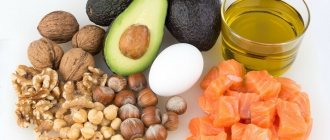The article was prepared by a specialist for informational purposes only. We urge you not to self-medicate. When the first symptoms appear, consult a doctor.
- How much can you drink omega-3 without interruption?
- Omega 3:6:9 ratio
- Benefits for the Heart
- Plant sources of omega 3
- Fish oil and fish oil - what is the difference?
- Should you worry about mercury in fish?
What is Omega 3?
Omega-3 is a general definition of a group of polyunsaturated fatty acids. These compounds are necessary for full human life. Essential fats include: alpha lipoic (ALA), eicosapentaenoic (EPA), docosahexaenoic (DHA) acids (abbreviated as ALA, EPA and DHA). The body cannot synthesize fatty acids on its own, so it is necessary to enrich the daily menu with certain foods.
The long chain fatty acids DHA and EPA are converted by the body from ALA. The transformation reaction proceeds slowly, producing a limited amount of the final valuable compound. As an additional source of EPA and DHA, cardiologists and nutritionists around the world recommend using fatty sea fish (tuna, salmon) and marine crustaceans (crabs, oysters).
Omega 3 fatty acid deficiency affects 20% of the world's population, according to a 2021 global study.
What is the difference between fish oil and omega 3?
Fish oil is an oil that is isolated from certain types of fish (tuna, herring, mackerel, anchovies). Omega-3 is a component of fish oil. It accounts for approximately 30% of the total volume. The remaining 70% of fish oil consists of other fats, vitamins D and A.
Fish Caviar (1086 mg per serving)
Among the products containing omega-3 fatty acids, fish roe is present in large quantities.
Fish roe is usually considered an expensive delicacy and is most often consumed in small quantities in addition to first courses and as an appetizer.
Caviar is high in choline and exceptionally low in omega-6 fatty acids (14).
Omega-3 content : 1086 mg per tablespoon (14.3 g) or 6789 mg per 100 grams (14).
Daily Value of Omega 3 for Men, Women and Children
| Age | Male | Female |
| From birth to 12 months | 0.5 g | 0.5 g |
| 1–3 years | 0.7 g | 0.7 g |
| 4–8 years | 0.9 g | 0.9 g |
| 9–13 years | 1.2 g | 1.0 g |
| 14+ years | 1.6 g | 1.1 g |
| Pregnancy | 1.4 g | |
| Lactation | 1.3 g |
US Department of Health
According to MR 2.3.1.2432-08 of the Russian Federation, omega 3 should be 1-2% of the daily caloric intake for men and women starting from 14 years old, which ranges from 500 mg to 1 gram (this volume includes EPA and DHA). For children under 14 years old - 0.8%-1%.
The norm for athletes . For athletes, recommendations for the use of omega-3 were approved by the International Olympic Committee, without dividing the supplement by type of acid. Your daily dose of omega-3 fatty acids, approximately 2 grams, can come in the form of supplements or fatty fish.
Minimum norm of DHA and EPA . The daily dose of combined EPA and DHA, according to WHO recommendations, ranges from 200 to 500 mg. An increase in the volume of fatty acids is necessary for people susceptible to cardiovascular diseases and pregnant women.
A safe dose of fish oil to take daily is up to 3 grams. Exceeding the dosage is dangerous due to the high risk of bleeding due to the ability of fish oil to thin the blood.
How much can you drink omega-3 without interruption?
The body does not synthesize polyunsaturated fatty acids on its own. Omega-3 supplements can be taken continuously.
At what age can a child be given omega-3?
Omega-3 is indicated for use from the first days of life. The pediatrician calculates the dose of the drug individually. Usually, during the first year of life, babies are given 0.5 g. For convenience, omega-3 is used in liquid form, adjusting the dose with a pipette. For older children, supplements in the form of chewing candies are suitable.
Unsaturated fatty acids: Omega 3
Back in the 70s of the last century, Danish scientists became interested in the health of the Eskimos who lived on the shores of Greenland - they, unlike a good half of humanity, did not have any problems with the cardiovascular system. After conducting a series of studies, scientists found that the content of bad cholesterol in the blood of Eskimos was an order of magnitude lower than that of other populations, and this despite the fact that they consumed the same amount of fatty foods!
A few years later, another newspaper published a more detailed study in which scientists took a closer look at the diet of Eskimos and found that they consumed a certain type of fat from oily fish much more and more often than is typical in other diets - this is how scientists learned about polyunsaturated fats. acids, about long chains of EPA (eicosapentaenoic acid) and DHA (eicosapentaenoic acid) and DHA (docosahexaenoic acid) and that Omega-3 is not synthesized by the human body, and therefore must come from outside.
You may be interested in: Everything you wanted to know about GLUTEN
In the eighties and nineties, scientists conducted studies on rats, depriving them of important macronutrients - in particular Omega-3. During the study, rats deprived of adequate nutrition were more likely to get sick and suffer from diseases. Epidemiological studies in the field of cardiology supported the theory of the effectiveness of the use of polyunsaturated fatty acids for the prevention and treatment of cardiovascular diseases, and at the beginning of the 21st century, scientists proved that taking Omega-3 helps treat some mental illnesses, such as depression and slows down degenerative processes in time of dementia, in particular in Alzheimer's and Parkinson's diseases.
How is omega-3 different from omega-6 and 9?
The difference between Omega groups is their specific effect on the body.
Omega 3 – prevent heart and vascular diseases, have unique properties, which will be discussed below.
Omega 6 – contains eicosanoid acid, which directly affects the formation of immunity. A complex of fatty acids provides a person with energy. Excessive intake of omega-6 increases the likelihood of developing inflammatory processes and related diseases.
Omega 9s are monounsaturated. The most common of these is oleic acid. The body is able to synthesize it on its own. Medical observations have shown that consuming foods rich in monounsaturated fats helps reduce signs of inflammation and increase insulin sensitivity. Omega-9 acids are found in large quantities in olive oil - about 80% of the total volume.
Omega 3:6:9 ratio
The diet of the modern population is dominated by the so-called Western diet, oversaturated with omega-6. It is deficient in omega-3. Before the industrial revolution, the human diet had a ratio of omega-6 to omega-3 ranging from 4:1 to 1:4. Investigations by anthropologists have shown that during the process of evolution this ratio was approximately 1:1. In the modern diet of the population, the proportion is about 16:1 [1].
The optimal ratio of omega-3 to omega-6 fatty acids ranges from 1:1 to 1:4.
A natural question arises - what to do? There is only one solution - to reduce the consumption of foods rich in omega-6. This primarily applies to vegetable oils and processed foods high in omega-6 fatty acids. First you need to figure out which vegetable oils are healthy and which are not.
The maximum amount of omega-6 is recorded in the following oils:
- Sunflower - 40% (1:200).
- Soy - 50% (1:7).
- Cotton - 51% (1:257).
- Corn - 53% (1:46).
It is necessary to introduce healthy oils into the diet, which contain very little omega-6:
- Coconut - 2% (winner).
- Creamy - 3% (1:7).
- Lard - 9% (1:9).
- Palm - 9.1% (1:46).
- Olive - 9.7% (1:13).
Due to its pronounced medicinal properties, special attention is paid to:
- Flaxseed oil - 17% (1:0.3).
- Ryzhikov - 33% (1:1).
- Hemp oil - 54% (1:2).
Flax Seeds (2,338 mg per serving)
Flax seeds are small brown or yellow seeds. They are often ground before consumption or used to obtain flaxseed oil.
These seeds are the richest source of omega-3 fatty acids in the form of alpha-linolenic acid (ALA). Therefore, flaxseed oil is often used as an omega-3 supplement.
Flaxseeds are also very rich in fiber, vitamin E, magnesium and other nutrients. They have an excellent ratio of omega-6 to omega-3 fatty acids compared to most seeds (15, 16, 17, 18).
Omega-3 content : 2,338 mg per tablespoon (14.3 g) of whole seeds or 7,196 mg per tablespoon (14.3 g) of oil (15, 16).
You can learn more about the benefits of flax seeds for the human body on this page - Flax seed: beneficial properties and contraindications, how to take it.
The Huge Benefits of Omega 3 Fats
Omega-3 fatty acids have been studied for quite some time. It has been established that they have a number of useful properties:
- Reduce blood pressure parameters.
- Prevents the development of arrhythmia.
- They inhibit the formation of plaques in the lumen of the arteries.
- Reduce triglyceride levels.
- Reduce the risk of stroke and heart attack.
- Reduce the risk of sudden death in people with heart disease.
A healthy, balanced diet should include fatty fish at least twice a week. This diet is suitable for people with a low risk of cardiovascular disease.
Benefits for the Heart
Cardiac ischemia . The ability to reduce the likelihood of heart pathologies is most pronounced when omega-3 is consumed by patients with a history of coronary disease. In one study, more than 18 thousand subjects with high blood cholesterol levels were divided into two groups. In one of them, participants received 1.8 g of EPA and a statin daily, in the other - only the statin. After 4.6 years, the results were assessed. In the group receiving EPA, there were 19% fewer cases of serious coronary events than in the control sample. Unstable angina and cardiac disorders without death also occurred much less frequently in the first experimental group [2].
Myocardial infarction . In the group of participants taking a daily omega-3 supplement, there was a significant 28% reduction in the incidence of myocardial infarction. Among African Americans, the decrease was 77%; among those who ate less than 1.5 servings of fish per week, the decrease was 40% [3]. According to another medical experiment, daily consumption of omega-3 helped reduce the risk of death from heart disease and blood vessels by 19%. In the placebo group, a similar effect was not recorded [4].
The effect of omega-3 on the development of stroke could not be established. Some scientists believe that the expected effect could be observed by increasing the dose of omega-3. This volume of drugs should be taken only under the supervision of the attending physician. Research in this area is ongoing.
Reduced triglycerides . Daily consumption of omega-3 helps reduce triglyceride levels by 15 to 30%. This effect was more pronounced in participants with higher triglyceride levels [5].
Protects against blood clots . Platelet aggregation underlies the formation of a blood clot. Omega-3 prevents platelets from sticking together, which means it prevents the development of a pathological process.
Protection against atherosclerosis . Omega-3 prevents the formation of atherosclerotic plaques. Fatty acids protect artery walls from damage and ensure their healthy condition [6].
Increases “good” cholesterol . Under the influence of omega-3, the volume of HDL in the blood increases [7].
Cancer prevention . Published research on the effects of omega-3s on cancer development does not show any consistent pattern. Some experts say that high doses of fatty acids reduce the likelihood of developing colorectal and breast cancer.
Breast cancer . A large Singapore Chinese study of 35,298 women aged 45 to 74 found that consuming omega-3s reduced the risk of breast cancer. After 5.3 years, the incidence of breast cancer in the group taking omega-3 was 26% lower than in the control sample [8].
Another experiment involving 35,016 women aged 50-76 years lasted 6 years. The final results showed that women who took fish oil supplements reduced their risk of developing breast cancer by 32% [9].
Bowel cancer . Several medical studies and subsequent analyzes have shown that consuming omega-3s reduces the likelihood of colon cancer by up to 34% [10], [11], [12].
Protection against stroke and heart attack. In 2021, an extensive study was conducted that included 8,179 people suffering from cardiovascular disease. Initial laboratory tests revealed high levels of cholesterol and triglycerides in all subjects. For 4.9 years, the first group of subjects received 4 g of Vascepa daily, containing 4000 mg of purified 96% EPA, and the second received a placebo. The results of the study showed that in the first group, the cases of acute cardiovascular pathologies - non-fatal forms of stroke, heart attack, unstable angina, coronary revascularization, and cardiac death - decreased by 25%. Finally, data were published on Vascepa's ability to reduce adverse outcomes:
- Cardiovascular death - by 20%,
- stroke (non-fatal, fatal) - by 28%,
- myocardial infarction (non-fatal, fatal) - by 31% [37].
How is omega-3 beneficial for women?
Relieves menstrual pain . Gynecologists define monthly menstrual pain and cramps as dysmenorrhea. Most women are familiar with this condition, which is caused by strong contractions of the uterus as a result of the action of prostaglandins. Two authoritative studies have shown that omega-3 fatty acids can relieve menstrual pain. This is explained by the pronounced anti-inflammatory properties of the substances [13], [14].
A gynecological experiment showed that consuming omega-3 eliminates menstrual pain much faster and more effectively than ibuprofen [15].
Relieves rheumatoid arthritis . According to statistics, women are almost three times more likely to develop rheumatoid arthritis than men. As a rule, the disease develops in the middle age group.
The results of studies in 2012 and 2021 showed that the use of fish oil preparations alleviates the feeling of morning stiffness and swelling of the joints, relieves pain, and alleviates the symptoms of inflammation. With omega-3, patients take NSAIDs less [16].
Prevents osteoporosis . Postmenopausal women are susceptible to osteoporosis. The disease develops as a result of a decrease in estrogen. Studies published in 2012 and 2021 showed that omega-3 supplementation improves bone mineralization. When taken together with calcium, this effect is enhanced [17], [18].
Protects against depression and. An analysis of 26 studies found that eating a lot of fish reduced the risk of depression by 17% [19]. It is noted that with severe depression the effect is not observed. Taking omega-3 helps reduce aggression.
Moisturizes the skin, removes wrinkles . The body's own DHA is found in the structure of the skin. It ensures the normal condition of cell membranes. The healthier the cell membranes, the softer and more elastic the skin. EPA contained in omega-3 has positive effects on the skin:
- Stimulates the synthesis of its own oils.
- Moisturizes.
- Prevents the formation of small red nodules that appear during the process of hyperkeratinization of hair follicles.
- Inhibits the processes of premature aging.
- Prevents acne.
Omega-3 active substances protect the skin from the negative effects of solar radiation and prevent the destruction of collagen in the dermal layers.
Omega-3 during pregnancy
Medical research over several years has concluded that consumption of seafood by pregnant and lactating women has a positive effect on the health and development of newborns. DHA, contained in fish oil, stimulates the formation of hand-eye coordination in children under 3 years of age [20].
At the same time, several other data were published. The organizers of 11 controlled experiments presented facts proving the absence of any benefits from the use of omega-3 during pregnancy and breastfeeding in relation to the formation of visual and cognitive functions.
The facts remain indisputable that DHA is finally concentrated in the retina of the eyes by the birth of the baby. In the brain, the accumulation process continues throughout the first two years of life.
Women who are breastfeeding are recommended to include at least 200-300 mg of DHA in their daily diet. A sufficient amount of valuable elements in breast milk is obtained by eating fish dishes 1-2 times a week.
Allergy protection . Observations of pregnant women have revealed that regular intake of omega-3 fatty acids into the mother’s body protects the child from allergic diseases in the future [21].
[Video] Nutritionist Ekaterina Didyk - why drink Omega-3 and how to choose it?
Benefits for children
Attention deficit hyperactivity disorder (ADHD) . ADHD is understood as a disorder of behavioral functions, which is accompanied by decreased concentration, impulsive reactions, and excessive activity. As laboratory studies have shown, children with established ADHD have lower levels of omega-3 in the blood than their peers without this disease. Following this, it was found that regular use of fish oil supplements helps mitigate the symptoms of ADHD.
The administration of omega-3 has a calming effect, suppresses aggression, and softens the manifestations of impulsivity and hyperactivity. By influencing the child’s central nervous system, fatty acids stimulate attention and facilitate the performance of certain tasks and skills [22], [23].
The obtained observational results showed that omega-3 drugs will eventually take a leading position in the treatment of ADHD [24].
[Video] Dr. Berg - ADHD in children and adults due to nutrient deficiencies:
Type I diabetes in children . Scientists have concluded that the intake of omega-3 within a year after the birth of a child reduces the likelihood of developing autoimmune pathologies:
- Type I diabetes.
- Multiple sclerosis.
- Autoimmune diabetes [25].
Benefits for various other diseases
For eyes . The active components of omega-3, namely DHA, inhibit the mechanism of macular degeneration of the eye. Thus, fatty acids prevent irreversible eye damage with subsequent development of blindness.
One of the medical experiments involved 2,275 people in the age group of 65 years and older, who were divided into two groups. The result showed that in the sample that ate fatty fish, the risk of neovascular age-related macular degeneration was 53% less likely than in other participants [26].
Hepatosis is a disease characterized by fatty liver disease. The use of omega-3 improves fat metabolism and alleviates signs of inflammation [27].
Improved sleep . A lack of fatty acids causes sleep problems in childhood. In adults, omega-3 deficiency threatens obstructive sleep apnea. Both phenomena are associated with low levels of DHA, which affects the concentration of melatonin, the hormone that promotes sleep.
Observations of subjects of different age groups prove that the quality and duration of sleep improves with the use of omega-3 [28].
The benefits of omega-3 in sports
Relieves muscle pain . Omega-3 acids relieve muscle pain, eliminate tissue swelling, and restore motor range after strength training. The combination of protein sports drinks with fish oil preparations alleviates signs of fatigue and reduces the symptoms of myalgia [29].
Protein synthesis . Fatty acids are involved in the growth of muscle fibers, which is very important for athletes. The body converts protein into building material and energy - the most important components that ensure growth and physical endurance. In physiology, this phenomenon is called protein synthesis. Omega-3s stimulate this process due to the presence of EPA and DHA [30].
Delivers more oxygen . Omega-3 active elements maintain heart health, which is very important for athletes. Observation of 16 cyclists proved that the use of fish oil normalizes heart rate and reduces the need for oxygen during sports activities. Experts have found that these processes occur without compromising performance and without harming the myocardium or skeletal muscle fibers [31].
Improved response . Scientific experiments have proven that regular use of drugs with omega-3 preserves cognitive processes and accelerates the responses of the nervous system. The data were obtained after observing 24 female football players who, after a course of taking fish oil preparations, showed activity in neuromotor functions [32].
Burn fat and reduce cortisol . Omega-3 has an inhibitory effect on the release of cortisol. Low levels of stress hormone directly affect the reduction of body fat and stimulation of muscle growth [33].
Signs of Omega-3 PUFA Deficiency
- Low weight in a newborn baby
— this statement was based on a study of 12 thousand Danish children.
- Premature birth
- were associated with a decrease in the concentration of docosahexaenoic acid in the child’s blood.
- Decreased visual acuity
— in addition to the previously mentioned mechanisms of action of omega-3 fatty acids, their inhibitory effect on apoptosis (self-programmed death) of retinal epithelial cells is also noted.
- Cognitive impairment
— in particular, are accompanied by a decrease in the concentration of tissue hormones such as neuroprotectin D, in the synthesis of which DHA is involved. This biologically active compound inhibits the apoptosis of nerve cells by activating a complex cascade of signaling processes and thereby suppresses the development of inflammation.
In addition, docosahexaenoic acid itself directly inhibits the formation of pro-inflammatory molecules - in particular, in the hippocampus - one of the most important structures of the brain involved in the mechanisms of transition of short-term memory to long-term memory, as well as in the formation of emotions.
- ADHD
- attention deficit hyperactivity disorder, accompanied by impaired ability to concentrate, impulsive behavior, lack of self-control and self-control.
- Mental and behavioral disorders
- are associated with accelerated atrophy (under conditions of omega-3 PUFA deficiency) of the gray matter of the brain (in particular, in the area of the following structures: the hippocampus, amygdala, cingulate gyrus, prefrontal and temporal cortex), as well as with a violation of the integrity of the white matter.
Thus, in rodents unable to accumulate DHA, behavioral abnormalities, the development of a depression-like state, and an increase in heart rate were observed.
- Dyslipidemia
(increased levels of cholesterol and/or triglycerides in the blood, decreased HDL) and increased risk of atherosclerosis and cardiovascular diseases.
A 30-year study of several thousand American scientists showed that eating fish (at least 2 times a week) significantly reduced the likelihood of myocardial infarction.
- Skin diseases
. Omega-3 PUFAs are used not only in aesthetic medicine as a prevention and treatment of skin aging (due to their activation of the formation of the main protein of connective tissue - collagen), but are also actively used in dermatology in the treatment of acne, atopic dermatitis and even psoriasis.
Interestingly, in an autoimmune disease like psoriasis, which causes red patches, omega-3 metabolites are also found in these plaques - these are thought to be converted into much weaker inflammatory molecules than, say, omega-6.
We recommend
“Psychology of stress: types, stages, ways of dealing with it” Read more
Which foods contain more omega 3?
For your convenience, we have divided the rating into plant-based and animal-derived products. Remember that plant omega has a significantly lower impact on human health due to the lack of EPA and DHA fatty acids in its composition.
Plant sources of omega 3
Flaxseed oil53.4 g
Flax seeds22.8 g
Chia seeds 17.8 g
Walnut9.1 g
Soy1.4 g
| Other herbal products (100 g) | ALA content (g) |
| Rapeseed oil | 9,14 |
| Hemp seeds | 8,68 |
| Soybean oil | 6,79 |
| Mayonnaise | 5,33 |
| Corn oil | 1,16 |
| Cracker | 0,96 |
| Multigrain crispbread | 0,92 |
| Bulb onions | 0,79 |
| Salo | 0,48 |
| French fries | 0,22 |
| Pistachios | 0,21 |
Animal Sources of Omega 3
Mackerel2.8 g
Cod liver oil 1 tablespoon (15 ml) 2.7 g + vitamin D - 34 mcg
Salmon2.6 g
Herring2.36 g
Anchovies2.1 g
Sardines1.5 g
Fish roe 1 tablespoon (14.3 g) 1.1 g
| Other types of fish (100 g) | Omega-3 content (g) |
| Salmon | 2,36 |
| Chinook | 2,25 |
| Coho salmon | 1,81 |
| Omul | 1,76 |
| Whitefish | 1,66 |
| Pink salmon | 1,59 |
| Oysters (Pacific/Eastern) | 1,58/0,58 |
| Saira | 1,43 |
| Red salmon | 1,39 |
| Trout | 1,21 |
| Horse mackerel | 0,98 |
| capelin | 0,95 |
| Smelt | 0,94 |
| Tuna | 0,93 |
| Perch | 0,92 |
| Mussels | 0,89 |
| Catfish | 0,83 |
| Squid | 0,75 |
| Chum salmon | 0,70 |
| Shrimps | 0,60 |
| Sturgeon | 0,59 |
| Carp | 0,43 |
| Hake | 0,41 |
| Mullet | 0,32 |
| Atlantic halibut | 0,23 |
| Pollock | 0,20 |
| Som | 0,14 |
The concentration of omega-3 in different varieties of fish varies significantly. Fatty fish caught in cold sea waters, such as sardines, tuna, salmon, and mackerel, contain high levels of fatty acids. Much less omega-3 is found in less fatty fish - perch, cod, telapia. Small amounts of fatty acids were also found in shellfish.
Farmed fish contain much less EPA and DHA than fish that live freely in the sea. The concentration of valuable acids depends on the type of fish nutrition. For example, farmed Atlantic salmon in Scotland lost significant amounts of EPA and DHA when natural marine ingredients were replaced with other ingredients. This trend was established after analysis of fish carried out from 2006 to 2015 [34].
[Video] Dr. Berg - the benefits of fish for the brain and eyes:
How is omega-3 from flaxseed oil different from omega-3 from fish oil?
Let us immediately clarify that omega-3, which is part of fish oil, has more valuable properties than omega-3 of plant origin. Flaxseed oil is no exception in this sense.
Of the three main types of omega-3 fatty acids (EPA, DHA and ALA), flaxseed oil only contains alpha-linolenic acid (ALA), while fish oil contains all of them. As stated above, ALA does not have the activity of eicosapentaenoic and docosahexaenoic acids and serves primarily as a fuel for energy production. The body also tries to convert it into EPA and DHA to make it beneficial for health [35].
However, our body is not able to fully convert ALA. Of its total volume, only 5% is transformed into EPA, and only 0.5% into DHA [36].
It should also be said that thanks to the record amount of ALA in flaxseed oil (8000 mg per tablespoon), even this 5% will satisfy 400 mg of EPA and 40 mg of DHA. If you take 3 tablespoons a day, you will exceed your requirement of these fatty acids even without eating fish.
EPA and DHA are the most important acids in omega-3
Omega-3 fatty acids include the following:
- Docosahexaenoic acid (DHA) is a long-chain chemical. DHA is involved in the formation of neuronal synapses, which transmit signals between cells. The presence of DHA ensures the fluidity of cell membranes. The largest amount of DHA was found in the cells of the eyes (93%) and brain (97%), with the maximum in the sections responsible for attention and mental processes.
- Eicosapentaenoic acid (EPA) has a long chain structure. The active substance affects the maintenance of health.
- Alpha-linolenic acid (ALA) has a short-chain structure. ALA provides the body with energy and protein to build DHA and EPA. Considering the fact that only 5% of ALA is converted to EPA and 0.5% to DHA, its daily dose should be quite high.
Plant foods contain exclusively the fatty acid ALA. The exception is some seaweed.
Foods rich in EPA and DHA
| Product (100 g) | EPA, mg | DHA, mg |
| Red and black caviar (100 g) | 3130 | 4340 |
| Salmon oil (1 tbsp) | 1760 | 2470 |
| Cod liver oil (1 tbsp) | 930 | 1470 |
| Mackerel | 890 | 1400 |
| Salmon (Atlantic) | 860 | 1100 |
| Fresh herring | 910 | 1106 |
| Pickled herring | 853 | 553 |
| Anchovies | 800 | 910 |
| Sardines | 870 | 529 |
| Bluefin tuna | 364 | 1144 |
| Tuna canned | 233 | 629 |
| Coho salmon | 544 | 833 |
| Sea bass | 208 | 562 |
| Shrimps | 292 | 252 |
Considering the high cost of salmon (trout, salmon) and red (especially black) caviar, be sure to include herring or mackerel in your diet. Just 100 grams of these fish more than meets the body’s entire need for healthy fats.
What should vegetarians do?
In the wake of the popularity of vegetarianism, the issue of providing followers of a plant-based diet with valuable fatty acids has become acute. This also applies to people who are intolerant to seafood. There is a solution - you should increase your consumption of nuts, soy products, various types of seeds, and green leafy vegetables. You can fully provide your body with omega-3 acids using vegan supplements that include EPA and DHA derived from algae.
Table of omega-3 and omega-6 content in products
Data on the content of omega-3 fatty acids in foods are summarized in the table.
| Product | Measure | Omega-3 content | Omega-6 content |
| Mackerel | 100 g | 5134 | 369 |
| Salmon (sea) | 100 g | 2585 | 220 |
| Salmon (farm) | 100 g | 2260 | 666 |
| Cod liver | 100 g | 19135 | 935 |
| Herring | 100 g | 1742 | 131 |
| Oysters | 100 g | 672 | 58 |
| Sardines | 100 g | 1480 | 3544 |
| Anchovies | 100 g | 2149 | 367 |
| Fish roe | 100 g | 6788 | 81 |
| Omega-3 Algae Supplements | 1 capsule | 400-500 mg | 0 |
| Flax seeds | 100 g | 64386 | 16684 |
| Linseed oil | 100 g | 53304 | 12701 |
| Chia seeds | 100 g | 17694 | 5832 |
| Walnut | 100 g | 9079 | 38091 |
| Soya beans | 100 g | 1443 | 10765 |
How to choose the right omega-3?
- Do not buy fish oils obtained from fish livers. They contain less valuable acids than fish oil extracted from fish muscles, and contain an excess of vitamin A.
- Choose supplements with lower levels of vitamin A—no more than 1 g per day (1000 mcg).
- Pregnant women and nursing mothers should not take vitamin A supplements in the form of retinol (which is found in abundance in fish liver). Vitamin A is considered safe in the form of beta-carotene (a plant form that does not cause overdose).
- The body should receive at least 500 mg of EPA and DHA per day (in total). This dose corresponds to 140-200 g of oily fish per week.
- Fish oil thins the blood, so you should consult your doctor if you are constantly taking aspirin, warfarin or heparin.
- If you are a vegetarian or vegan, you can take seaweed supplements.
Read the label carefully before purchasing! For 1000 mg of fish oil, there should be at least 500 mg of EPA and DHA (the sum of both).
Fish oil and fish oil - what is the difference?
Fish oil is oil obtained from the liver of fish. This fat is always cheaper, but it contains a lot of vitamin A and D, and also consists of more than 70% of various other fatty acids in addition to omega 3. Its main advantage is its low cost.
Fish oil is fat obtained from the muscle tissue of fish. This is a more refined product, higher quality, but also more expensive.
Omega-3 - instructions for use
Indications. Omega-3 supplements restore the elasticity of blood vessels and prevent the formation of cholesterol plaques, therefore they are primarily recommended for people with cardiovascular disorders.
In addition, omega-3 is indicated for:
- Digestive dysfunction.
- Normalization of the functioning of the endocrine glands.
- Diabetes mellitus to restore physiological metabolism, restore lipid metabolism.
- Stress.
- Neuro-emotional stress.
For complete absorption, omega-3 should be taken together with foods containing fat, fat-soluble vitamins E and D. Dietary fats ensure the absorption of valuable fatty acids. For example, DHA is absorbed up to 90% in the presence of fats, and up to 69% without them. The absorption of ethyl esters generally increases 3 times [38].
Walnuts (2,542 mg per serving)
Walnuts are very nutritious and rich in fiber. They also contain high amounts of copper, manganese, vitamin E, and important plant compounds (20).
When consuming them, the peel should not be removed, as it contains a large amount of phenolic antioxidants, which have important beneficial properties.
Omega-3 content : 2,542 mg per 28-gram serving, equal to about 7 walnuts (20).
You can learn more about the benefits of walnuts for human health on this page - Walnuts: benefits and harm to the body.
What is krill oil? How is it different from fish oil?
Krill oil is a product obtained from Antarctic krill. These marine crustaceans occupy a certain place in the diet of whales, seals, and penguins. In krill, as in marine fish, high concentrations of EPA and DHA are found.
Still, there are certain differences from regular fish oil:
- Fish oil is characterized by a yellowish tint. Krill contains a natural antioxidant - astaxanthin (65 times stronger than vitamin C), which gives the oil its pink color.
- Krill oil fatty acids are absorbed more easily and in greater quantities than fish oil.
- Fish oil contains omega-3 in the form of triglycerides. In krill oil, the bulk of fatty acids are presented in the form of phospholipids, which greatly facilitate absorption and increase the effectiveness of omega-3.
- Krill oil contains more antioxidants, which have anti-inflammatory properties and protect the heart.
- Krill oil is more effective in lowering blood sugar levels than fish oil. At lower doses, krill oil is better at removing triglycerides and “bad” cholesterol.
Is it worth buying? Krill oil is superior to fish oil not only in beneficial properties, but also in price. The cost of the product is reflected in the method of collection and processing of ocean krill. Some types of krill are almost 10 times more expensive than fish oil.
Fish oil in natural form or in supplement form is available in pharmacies and is affordable. Fish oil fatty acids are presented in complex vitamin preparations from different manufacturers. Finding quality fish oil is easier than finding premium krill oil.
If financial resources allow, you can purchase krill oil. This way you will get an easily digestible product that is more valuable for the health of the heart and blood vessels.
Possible harm and contraindications
Exceeding the recommended doses of omega-3 can cause the development of arrhythmia, bleeding, and atrial fibrillation. These phenomena are observed when taking more than 3 g of omega-3 per day.
When purchasing, it is better to choose supplements with vitamin E. It prevents the oxidation of omega-3 fatty acids, which is manifested by a specific rancid taste. Store fish oil preparations in the refrigerator, where they are not exposed to light. Do not use expired omega-3 supplements. Old fish oil has an unpleasant odor.
Should you worry about mercury in fish?
In the natural environment, mercury in one form or another is found quite often. Industrial emissions contribute to its accumulation in the oceans and other water sources. When interacting with other substances, methylmercury is formed, which can be harmful. The toxic effect of mercury is dangerous for the fetus during pregnancy and for small children.
It should be noted that some types of fish are capable of accumulating mercury, for example, shark, king mackerel, tilefish, and swordfish. For safety reasons, it is necessary to minimize the consumption of these types of fish.
Pregnant women and nursing mothers should completely exclude the listed types of fish from their diet. Shellfish, small fish, and canned fish are allowed for them. A safe dose of fish for pregnant women is 350 grams of fish per week.
Conclusion
The intake of omega-3 into the body ensures the normal development and functioning of the brain and eyes. Fatty acids in fish oil eliminate signs of inflammation, prevent the development of cardiovascular diseases, and impaired brain activity. Supplements with omega-3 acids are useful for people with heart disease, blood vessels, and cerebrovascular disorders in a family history.
It should be remembered that consuming natural products is healthier than taking pharmaceutical supplements. In order to provide the body with the necessary amount of omega-3, it is enough to eat two servings of fish per week.
Fish is no less beneficial for human health than fish oil. However, omega-3 supplements are suitable for those who do not like fish or follow a vegetarian diet.
Author of the article:
Kuzmina Vera Valerievna |
Endocrinologist, nutritionist Education: Diploma of the Russian State Medical University named after. N.I. Pirogov, specialty “General Medicine” (2004). Residency at the Moscow State Medical and Dental University, diploma in Endocrinology (2006). Our authors
Omega-3 in the diet: benefits and benefits
Omega-3 takes an active part in the functioning of the human body, affecting the functioning of the heart, brain, internal organs and nervous system. Let's take a closer look at why taking Omega-3 is so important:
- Omega-3 and the circulatory system
A diet rich in Omega-3 fats can reduce the risk of many heart and vascular diseases. Taking Omega-3 helps increase cholesterol levels in the blood and reduces the level of “bad” cholesterol, preventing the development of atherosclerosis or thrombosis. Taking enough Omega-3 can reduce the risk of developing coronary heart disease and arrhythmia.
- Omega-3 and brain function
Fatty acids, in particular docosahexaenoic acid (DHA), are essential for the proper functioning of the cerebral cortex, they improve blood flow and also support the flow of nerve impulses between gray and white matter. Omega-3 is responsible for the proper functioning of the entertainment and coordination centers, and also has a positive effect on memory.
- Omega-3 and the immune system
Taking Omega-3 fatty acids has a positive effect on human immunity. These compounds stimulate the activity of white blood cells, which protect the body from bacteria and viruses. In this context, consuming sufficient amounts of Omega-3 is especially beneficial for pregnant women and young children, whose immune systems are just beginning to develop.
- Omega-3 and weight loss
Replacing animal and trans fats with unsaturated fatty acids has a positive effect on the process of losing weight. Omega-3 unsaturated fats do not accumulate in fat cells, have lower cholesterol levels, and also affect the regulation of insulin levels in the blood.
Products rich in Omega-3:
- fatty sea and river fish: salmon, tuna, herring, sea bass;
- fish oil: cod liver;
- crustaceans: lobster, crab, lobster;
- Cold-pressed vegetable oils: sesame, hemp, soybean, sunflower, walnuts, rice bran, rapeseed, corn;
- nuts: walnuts, brazil, almonds;
- seeds: flax, chia, pumpkin;
- green vegetables: broccoli, cabbage, green peas, soybeans, lentils;
- avocado.











